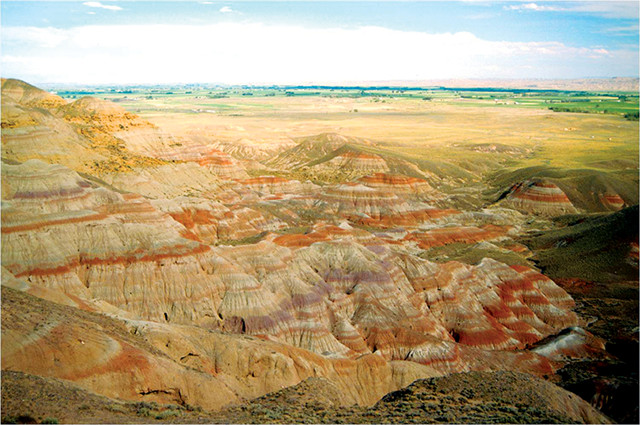
by Julia Rosen Monday, March 9, 2015

Cores of ancient soils collected from Wyoming's Bighorn Basin reveal new features of ancient climate change. Credit: Scott Wing, Smithsonian Institution.
Geologists are fond of the saying, “The past is key to the future.” Unfortunately, the past has been a poor guide when it comes to understanding modern climate change. Now, however, a new study suggests that one episode — a spike in global temperatures that occurred about 55 million years ago — may be a better analog than previously thought, and could yield insights into the planet’s future.
The event, known as the Paleocene-Eocene Thermal Maximum, or the PETM, occurred when huge releases of carbon into the atmosphere and ocean warmed Earth by 5 to 8 degrees Celsius. The planet also experienced severe ocean acidification and widespread reorganizations of terrestrial ecosystems.
“Things got pretty weird pretty fast,” says Gabriel Bowen, a geologist at the University of Utah and lead author of the new study in Nature Geoscience. But although scientists have studied the PETM intensively, they still debate where the carbon came from, why it was released and how fast.
To shed light on these questions, Bowen and his colleagues went looking in Wyoming’s Bighorn Basin for what is perhaps the most defining feature of the PETM in the geologic record: a large variation in the isotopic composition of carbon that accompanied the enormous release of greenhouse gases. This signal has been found in numerous PETM-aged records from around the world, including ocean sediments and ancient soils, where carbonate minerals preserve the carbon isotopic composition of atmospheric carbon dioxide.
When the researchers drilled into the fossilized soils of the Bighorn Basin, they found not one, but two distinct isotopic variations at the time of the PETM. One of the events, a short precursor episode that precedes the main warming by several thousand years, had never been documented before.
Bowen’s team calculated that the carbon releases that produced these isotopic signals must have come from two large pulses of emissions, the first lasting less than 2,000 years. At the peak of both burps, global carbon emissions likely approached 1 petagram per year — roughly one-tenth of modern emission rates, but much higher than previously thought. The second pulse initiated the main PETM event, and apparently pushed the climate and carbon cycle over a threshold; it took more than 90 thousand years for Earth to return to its pre-PETM state.
The idea that two pulses of carbon emissions occurred at the start of the PETM isn’t completely new, says Appy Sluijs, a paleoceanographer at Utrecht University in the Netherlands who was not involved in the study. But previous assertions relied on subtle hints in lower-resolution archives of a two-step change, which some interpreted as a smoothed record of two pulses. “This is a great start,” Sluijs says, but the finding “really needs to be reproduced somewhere else” before he’ll be convinced.
Assuming both peaks pop up in other sediment and soil cores, this new picture of the PETM may help scientists hone in on what caused it. The pulses imply that the mechanism behind the warming could have been capable of releasing a lot of carbon quickly and repeatedly, like large volcanic eruptions or plumes of seafloor methane.
Other hypotheses start to seem less likely, Bowen says, like tectonic changes or meteorite impacts. For example, “we’d have to have had two bolide impacts of the right size, spaced within a few thousand years,” he says — an unlikely occurrence.
The results may have important implications for understanding modern climate change and the physical, chemical and biological shifts that will come with it. “The benefit of looking back at events like this is that we can see the whole thing play out,” Bowen says. The PETM is not a perfect analog — peak emission rates then still don’t match modern rates, and Earth’s background climate was different — but it’s the best we have, Sluijs says.
One interpretation of the new data, in particular, suggests something troubling for the future, Bowen says. It’s possible that the first pulse of carbon in the PETM may actually have triggered the second — in other words, a short burst of early warming could have activated mechanisms that produced even greater and more sustained warming later. The same thing could happen if, for example, ocean warming due to anthropogenic climate change released large deposits of seafloor methane, he says.
It’s definitely possible, says Lee Kump, a geologist at Penn State University, especially considering that current emission rates outpace even these new upward estimates for the PETM. Now, Kump says, it’s just a matter of how long we keep it up. “If we can reduce carbon emissions dramatically over the course of the next few decades, then the impacts are likely to be much smaller.” Otherwise, he says, we may relearn the lessons of the PETM all over again.
© 2008-2021. All rights reserved. Any copying, redistribution or retransmission of any of the contents of this service without the expressed written permission of the American Geosciences Institute is expressly prohibited. Click here for all copyright requests.